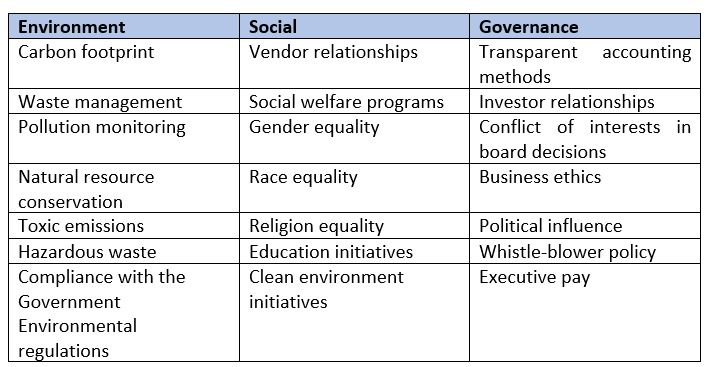Elements of an ESG report
 Share
Share
 Copy Url
Copy Url

The Environment, Social, and Governance (ESG) principles were first seen in the 1960s when ‘socially responsible investing’ was initiated for people who were against the Vietnam war and didn’t want to invest in companies that produced weapons.
Today, ESG has become an intrinsic element of investment decision-making. This is because ESG factors are directly linked with the sustainability of the organization. An ESG report helps convey that the company is operating in accordance with the Corporate Governance guidelines (formed by the National Foundation for Corporate Governance) and showcases the steps it has undertaken to preserve the environment.
The 3 essential elements of an ESG report
-
Environment
This section looks at the impact that the company has on the environment and is the toughest section from an investigative perspective. The resources that the company consumed from the environment and the resources that it emitted, should all be specifically stated. This section also highlights the consequences of the company’s operations on its surrounding environment and the lives that are a part of it. Below are some other essential environmental disclosures:
- Climate change – This is increasingly being recognized as a business risk. Conducting an analysis of where the company could stand after taking into account climate change will help it put measures in place to mitigate its contribution towards climate change.
- Water conservation – The demand for water is more than its supply. Organizations the world over are setting up their plants based on the availability of water and are also taking steps to reduce their hydropower. This part of the report can help companies lay down their plans for water conservation and highlight any progress they have made in this direction.
- Sustainable land use – This includes stating the manner in which your company has associated with the land it owns. Some of these activities could be construction, soil erosion, deforestation, or plantation and building of animal shelters.
- Recycling efforts – If the company has undertaken any steps to convert its waste material into any substances that can be re-used, here is where the company needs to state it.
-
Social
This section of the report accounts for the company’s relationship with all its stakeholders, other organizations it gets into business with, and largely the community within which it operates.
- Labor standards – Following these standards in letter and spirit will help companies create a good working environment and retain crucial talent. Reporting the same here will—apart from showcasing its employee-friendliness—help the company demonstrate the complications it tackled in doing so.
- Domestic and global human rights issues – Businesses that address human rights issues gain an edge over those that don’t. If organizations have taken steps towards inclusivity of the LGBTQIA+ community, invested resources into combatting human trafficking, helped people in an area affected by war or a natural calamity—or shouldered any other responsibility for human rights—it can be expressed in this section.
- Employee relations – Maintaining good employee relations will help increase productivity and employee loyalty, thereby bringing the company closer to achieving its ultimate goal. Reporting on the company’s efforts in this regard will help assure its stakeholders and potential investors that it is headed in the right direction.
- Welfare initiatives – These can include providing healthcare insurance to employees, access to gyms, counseling, libraries, and even healthy snacks. The provision of these initiatives will highlight the company’s concern for its people and have a positive bearing on its reputation.
-
Governance
The Governance section of the report looks at the internal policies and procedures that the company has in place to ensure ethical workings, effective decision-making, legal compliances, and external obligations.
- Cybersecurity measures – The pandemic brought out the importance of having proper cybersecurity measures in place. With everyone working from home, the company had to ensure that the integrity of data is not sacrificed. Several companies undertook technological modification, which they can report in this section.
- Data privacy – Data privacy is becoming an increasingly important concern for customers in every domain and if the company has measures in place to protect data, they can report them in this part.
- Minimizing tax legally – Through specified investments, companies can minimize tax and retain more profits within the company. If the company has claimed any deduction or availed any credit that reduced its tax liabilities, it can be stated here.
- Eliminating corruption – Companies that have a zero-tolerance policy toward corruption can express the same here and also present the nuances of the activities that are completely unacceptable to them.
While the above pointers cover the broad list of topics that can be included under the main headings, below is a more comprehensive list of everything that the company can report on under each section.

While an ESG report does not have a specified format, you should ensure that it covers all three elements transparently in its report.
Report Yak is a business reporting design agency that provides advisory services, conceptualizes, creates content, and designs annual reports, ESG reports, and impact reports for corporations. You can have a look at our award-winning work here or get in touch and we’d be happy to discuss your next report.
Related Posts
-
Simplifying ESG Disclosure for Better Impact
corporate reportingenvironmental and social initiatives
+6
Aug 28, 2025Share
Copy Url
GRI Sustainability Taxonomy: Learn How to Turn Data Into Advantage
corporate governancecorporate reporting
+11
Jul 1, 2025Share
Copy Url
See How Components of an Annual Report Drive Business Confidence
annual reportAnnual Report design
+7
Jun 24, 2025Share
Copy Url


